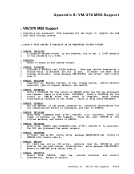If a block larger than 30 doublewords is returned via D~KPRET, it is merged appropriately into the regular free storage chain. Then, unless
the block was returned byDMKPRETR (see "Initialization") a check is made to see if the area given back (after all merging has been done) is
a page frame within the dynamic paging area. If so,D~KPTRFT returns it
to the dynamic paging area for subsequent use.~~~ ~!.Qraq~ ~g~ £:!:g.!~ !ll.Q£at!on The number of page frames allocated to free storage depends upon:
1. The real machine storage size
2. TheRKSIZE operand specified in the SYSCOR macro at system generation time
3 TheFREE operand in the SYSCOR macro
The storage size usedDY Vft/~/U is the smaller of the real machine storage size and the RKSIZE value.
If thePREE operand was not included in the SYSCOR macro statement for DKKSYS, the default number of fixed free storage pages allocated at IPL time for the first 256K of storage is 3 and 1 page for each 64K
thereafter, not includingV=R size, if any.
If the FREE operand was included in theSYSCOR macro statement for DMKSYS, that value is the number of fixed free storage page frames allocated at IPL time. If those pages represent an amount of free
storage greater than25% of the VK/370 storage size (not including V=R size, if any) the default allocation is used. CP INITIALIZATION System initialization starts when the operator selects the DASD device
address of theCP system residence volume (SYSRES) and presses the IPt button. The Systea/370 hardware reads 24 bytes from record 1 of
cylinder0 on SYSRES into location 0 of main storage. This record
consists of an initialPSW and a channel program. The channel prograa
reads the moduleDMKCKP into location 1'800' and gives it control. DKKCKP checks location CPID in module DMKPSA. If CPID contains the value CPCP or WARM, DMKCKP saves the spool file
control blocks,system log messages, accounting information, status of
spool devices, spool hold queue blocks, and spool record allocation
blocks and writes them on the warm start cylinders. IfCPID contains
the valueCPCP, DKKCKP loads a disabled wait state code 1'008'. If location CPID does not contain the value CPCP, DMKCKP nov loads DKKSAV and passes control to it at entry point DMKSAVRS. D~KSAV reloads
a page image copy of theCP nucleus into real storage starting at page O. When DKKSAV is finished, control is transferred to D~KCPI. D~KCPI performs the main initialization function. This includes calling DKKiRK to retrieve the information stored on the warm start cylinder. This
also includes callingDKKCKS to initialize the dynamic checkpoint
cylinders and to checkpoint the current status of the spool filesystem. When DMKCPI has finished, it passes control to D~KDSPCH. D~KDSPCH loads
a wait statePSi to wait for work. See "CP Initialization for the
Attached Processor" for additionalin~ormation. 1-122 IBM VM/370 System Logic and Problem Deteraination--Voluae 1
the block was returned by
a page frame within the dynamic paging area. If so,
to the dynamic paging area for subsequent use.
1. The real machine storage size
2. The
3 The
The storage size used
If the
thereafter, not including
If the FREE operand was included in the
storage greater than
address of the
cylinder
consists of an initial
reads the module
control blocks,
spool devices, spool hold queue blocks, and spool record allocation
blocks and writes them on the warm start cylinders. If
the value
a page image copy of the
also includes calling
cylinders and to checkpoint the current status of the spool file
a wait state
Attached Processor" for additional








































































































































































































































































































































































































































































